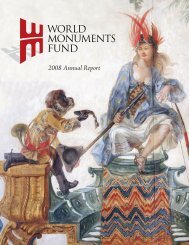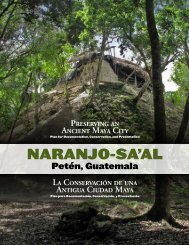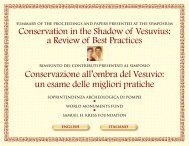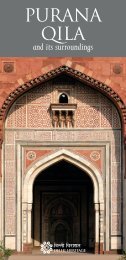Lalibela, Phase I (pdf) - World Monuments Fund
Lalibela, Phase I (pdf) - World Monuments Fund
Lalibela, Phase I (pdf) - World Monuments Fund
Create successful ePaper yourself
Turn your PDF publications into a flip-book with our unique Google optimized e-Paper software.
EXCAVATIONS<br />
By ingenuity, Dr. Angelini and his co-workers were able<br />
to achieve a much greater volume of archaeological<br />
excavations than originally planned. The native work force<br />
was increased from 200 to 400 and a primitive trolley-andcable<br />
bucket system was introduced to enable them to reduce<br />
radically the time and effort to remove the excavated earth<br />
to a satisfactory distance from the site - always a major<br />
problem in an archaeological excavation.<br />
Although the bulk of the 15,000 cubic yards of digging<br />
was designed to ensure adequate drainage of rainwater by<br />
exposing again the portions of the complex which had been<br />
covered over, and to impede the washing of rubble and stones<br />
into the courtyards, Dr. Angelini reports that he soon became<br />
fascinated with important historical discoveries. Digging in<br />
the area adjacent to Biet Mercoreos uncovered fragments of<br />
ancient pottery, a large copper plate of Oriental origin<br />
(probably from India), and iron tethers for chaining prisoners.<br />
Dr. Angelini belieyes that these findings support his theory<br />
that Biet Mercoreos was originally not a church, but the civil<br />
palace of a ruler who may have predated King <strong>Lalibela</strong>.<br />
The project director adds that, with the uncovering ofmany<br />
deep trenches and ditches, nearly all of the perimeter of this<br />
walled and moated city has been traced, and that if these<br />
excavations are adequately pursued, the aspect of the eleven<br />
single churches will be converted into a gigantic, integrated<br />
shrine and a sC1,llptured mountain - an important attraction<br />
for tourists, a laboratory for scholars, and a great ctiltural gift<br />
to the world. .<br />
34<br />
Upper photos: A previously unknown trench below Mount Tabor uncovered<br />
during <strong>Phase</strong> 1. Before and after. Lower photos: Another section of the<br />
same trench. Before and after excavations.
















